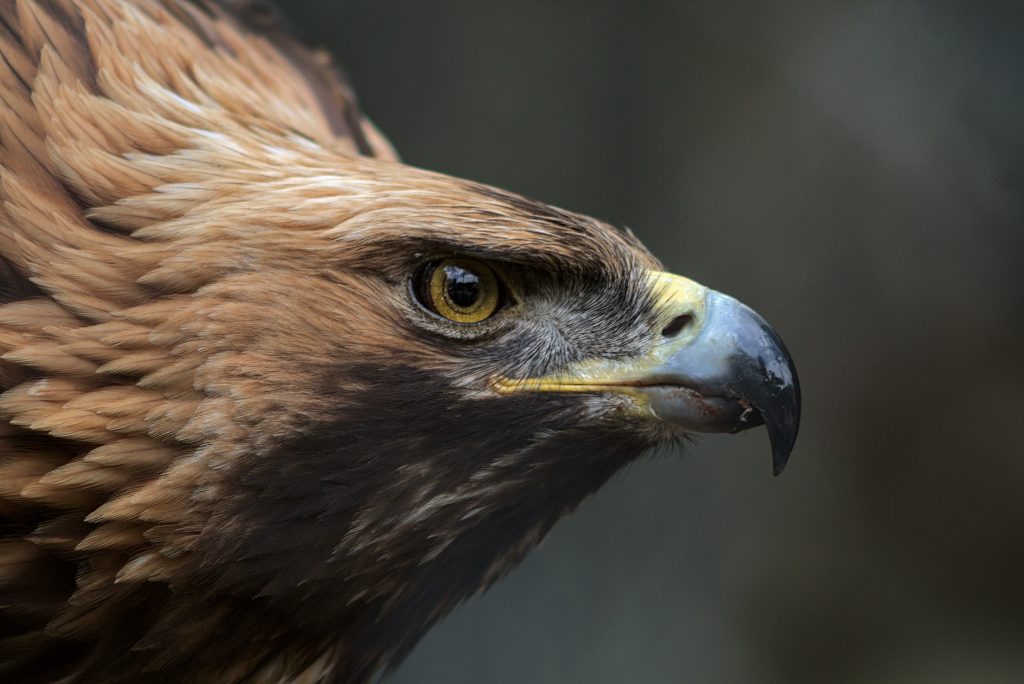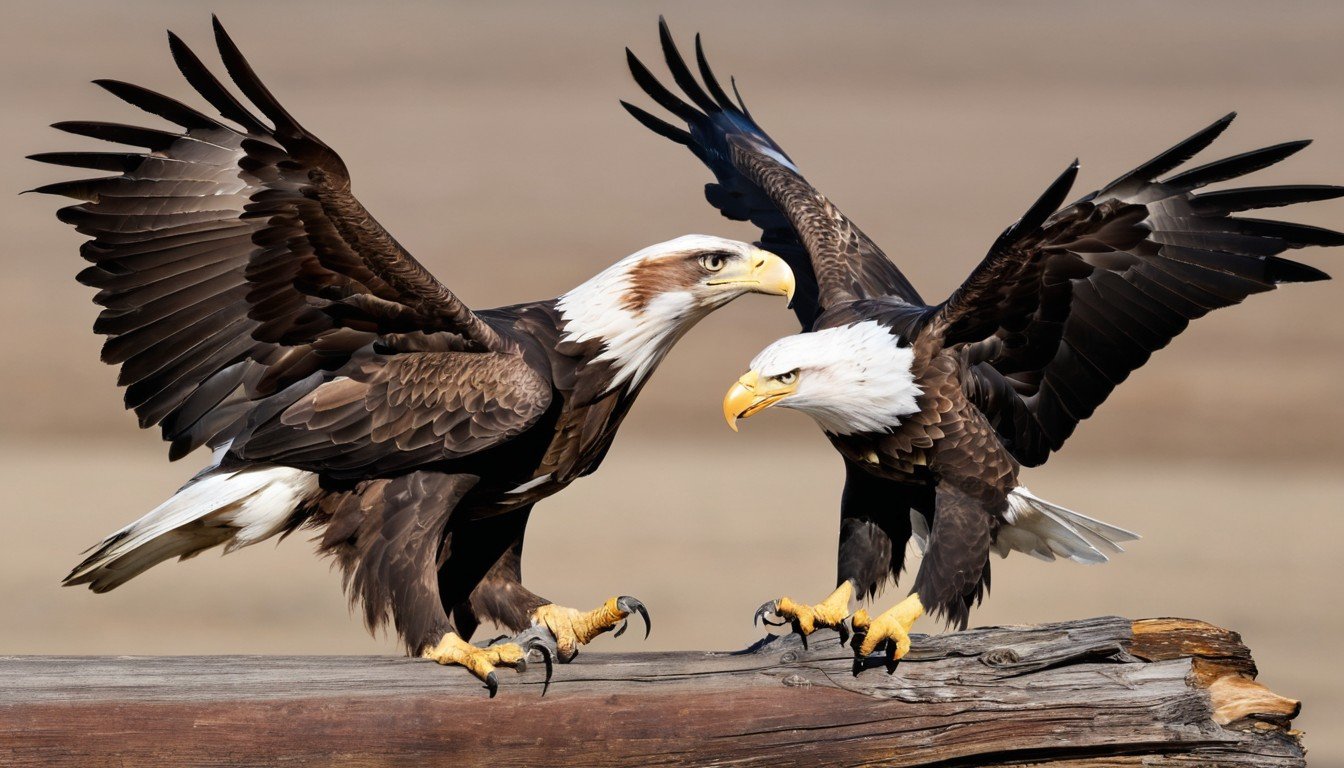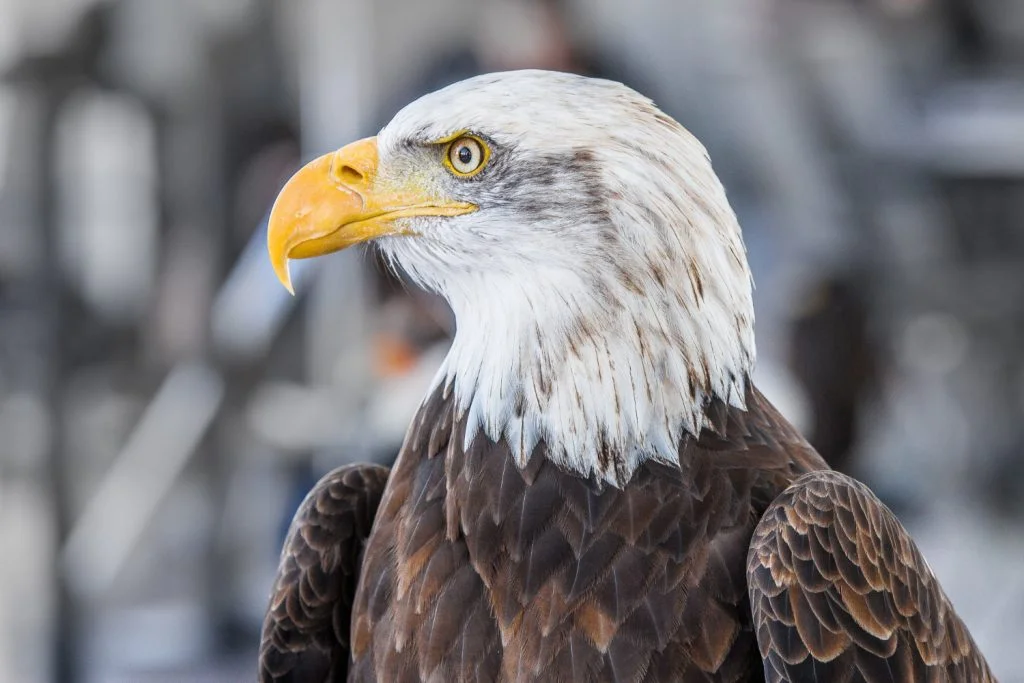Golden eagles vs bald eagles are two of the most majestic bird of prey species in North America. As famous raptors that share some physical similarities, bald eagles and golden eagles are often confused by bird-watching enthusiasts and average observers alike. However, upon closer inspection, several key differences set these birds apart.
This article will compare and contrast bald eagles versus golden eagles across a variety of characteristics. These include taxonomy, appearance, geographic range, habitat preferences, diet, nesting habits, and more. We’ll also touch on some similarities between the species as national symbols and North America’s largest birds of prey. Read on to boost your bald eagle and golden eagle identification knowledge.
Golden Eagle

The golden eagle is one of the most powerful and fastest-flying birds in North America. As a member of the booted eagle genus Aquila, it differs taxonomically from the bald eagle which resides in Haliaeetus. With dark brown plumage over most of its body and wings contrasted by a lighter golden-brown neck and head, a golden eagle in full adult regalia is an impressive sight soaring overhead.
Beyond its distinctive hood, thick beak, and namesake golden feathers, the golden eagle stands apart thanks to differences in geographic range, habitat preferences, diet, aerobatics, and more compared to the bald eagle. Golden eagles occupy wide open spaces across western North America, favoring high mountain cliffs and scrubland over waterways. An extremely skilled predator and scavenger ranging from California to Alaska to Mexico, the golden eagle epitomizes wilderness and adaptable survival.
Bald Eagle

The bald eagle has been the undisputed national emblem of the United States ever since its adoption in the 1700s. With unmistakable white head and tail feathers contrasting its dark brown body, the bald eagle cuts a commanding figure whether soaring through wetland skies or perched in riverside nests dotting America’s expansive coastlines.
As North America’s largest birds of prey that sometimes scavenge food opportunistically, bald eagles and golden eagles overlap in people’s minds. However, the bald eagle differs greatly from the golden eagle across factors ranging from taxonomic classification to geographic distribution, diet, aerobatic talents, nesting preferences, and conservation status. While often confused thanks to cursory similarities, dedicated birders recognize a number of key differences setting bald eagles apart from golden eagles.
Comparing Golden Eagles and Bald Eagles
The below table summarizes some of the major attributes that differentiate golden eagles and bald eagles at a high level:
| Attribute | Golden Eagle | Bald Eagle |
|---|---|---|
| Taxonomy | Genus Aquila (boot eagle) | Genus Haliaeetus (sea eagle) |
| Size | 30-40 inches long 6.5-14 lbs | 30-43 inches long 8-14 lbs |
| Wingspan | 6.5-7.5 feet | 6-8 feet |
| Plumage | Dark brown body Pale golden-brown neck/head | Dark brown body White head/neck/tail |
| Beak | Large yellow beak | Blackish beak |
| Ankles | Feathered | Unfeathered |
| Range | Western North America | Throughout North America |
| Habitat | Open country Mountains/deserts | Coasts/rivers/lakes |
| Diet | Small mammals/birds | Fish and carrion |
| Conservation | Not threatened | Recovered from endangerment |
However, taxonomy charts and physical dimensions alone do not communicate the full scope of differences that set bald eagles apart from golden eagles in the wild. Continue reading for an exploration of key distinctions across categories ranging from geographic distribution to hunting strategies and conservation status.
The 8 Key Differences Between Golden Eagles and Bald Eagles
While North America’s largest birds of prey display some superficial similarities, bald eagles’ and golden eagles’ differences run deeper. On dimensions ranging from feather patterning to geographic range, the bald eagle stands distinctly apart from its golden cousin.
Golden Eagles and Bald Eagles: Taxonomy
Golden eagles belong to the booted eagle (Aquila) genus while bald eagles are sea eagles of Haliaeetus. This means they hail from separate evolutionary branches. Booted eagles share common ancestors with other broad-winged raptors like the Eastern Imperial Eagle. In contrast, bald eagles descend from maritime birds of prey related to fish eagles and sea hawks. The taxonomic distinction is the first clue that bald eagles and golden eagles live notably different lifestyles fitted to separate ecological niches.
Golden Eagles and Bald Eagles: Habitat
When it comes to preferred natural landscapes, bald eagles and golden eagles could not differ more starkly. Bald eagles overwhelmingly occupy habitats in or near water. They nest in mature trees on lake shores, river banks, and coastal margins from Mexico to Canada to Alaska. Bald eagles also forage above wetlands and develop where humans settle near oceans, rivers, or marshlands.
Meanwhile, golden eagles eschew waterways and human proximity to inhabit wide open spaces including mountain wildernesses, canyon country, highland scrublands, and desert margins across western North America. As birds that prefer remoteness and soaring over high relief, golden eagles could not differ more starkly from bald eagles in terms of favored haunts.
Golden Eagles and Bald Eagles: Range
With a range spanning from Mexico to Alaska and coast-to-coast across Canada into Labrador, bald eagles beat golden eagles when it comes to geographic distribution across North America. Bald eagles occupy every contiguous American state along with Alaska and diverse terrain from Central America to the edge of the Arctic Circle.
Golden eagles on the other hand live only in western states and provinces from Mexico to British Columbia down to Texas over to the Dakotas. Golden eagles skip the Midwest and the entire eastern half of the continent which is firm bald eagle terrain. For bird enthusiasts ID’ing a massive bird of prey on Eastern rivers or Great Lakes coasts, it is bound to be a bald eagle. Out West over mountains and deserts, odds tilt toward spotting the golden eagle.
Golden Eagles and Bald Eagles: Plumage
When it comes to feather patterning, bald eagles’ distinctive white heads, and tails contrasting chocolate brown wings, and torso makes identification straightforward even for casual birdwatchers. Meanwhile, golden eagles bring a more subtle palette starting with dark brown plumage that covers the body and most of the wings. Golden eagles’ namesake lighter gold feathers emerge only on the crown, nape, and short skirt-like neck area.
Only mature bald eagles after about age five develop unmistakable white heads and tails with chocolate body plumage. Younger bald eagles display largely brown feathers similar to golden eagles, albeit with variable white mottling gradually increasing with age. Juvenile eagles of both species bring identification challenges. But uniform golden head feathers stand as a reliable mark of adult golden eagles.
Golden Eagles and Bald Eagles: Beak
Beak color offers another influential field mark setting golden eagles apart from bald eagles. Adult golden eagles develop striking yellow beaks which pop dramatically against their darker hooded heads. The huge hooked beak serves as a multi-purpose danger tool for attacking prey, stripping flesh from carcasses, and delivering defensive strikes able to cripple mammalian threats.
In contrast, bald eagles retain darker colored beaks ranging from grayish-black to blackish-brown with a yellow cere at the base. Instead of yellow, bald eagles sometimes reveal a small portion of brighter orange beak color but it never encompasses anywhere near the entirety of the beak-like golden eagles’ distinct yellow does.
Golden Eagles and Bald Eagles: Ankles
Sharp-eyed birdwatchers recognize bald eagles’ signature bare ankles compared to the fully feathered legs and ankles of golden eagles. Uncovered bald eagle ankles match their affinity for fish and willingness to wade into the water. Feathered golden eagle ankles demonstrate an adaptation that helps this species thrive in colder mountain and desert environments prone to winter snow and frigid temperatures.
Golden Eagles and Bald Eagles: Nests
When it comes to home building, golden eagles favor nesting on remote cliff ledges in steep terrain across much of western North America’s elevated mountain or canyon landscapes. Golden eagles build bulky nest stick platforms known as aeries adhered to ledges by slopes, canyons, and cliffs often hundreds of feet off the ground. Their nests tend to be found away from human activity in dramatically vertical settings.
In contrast, bald eagles construct some of the continent’s largest nesting structures tucked into trees (live or dead) adjacent to coastlines, rivers, lakes, and wetlands. Enormous bald eagle nests loom over watersides and marshy areas from Florida to the Great Lakes across Canada out to
Alaska. Rather than remote mountains, bald eagles feel most at home building nests near waterways with access to fish amid North America’s lowlands.
Golden Eagles and Bald Eagles: Diet
As birds of prey, golden eagles and bald eagles share common raptor traits like sharp talons and curved beaks evolved for tearing. But when it comes to dietary preferences, these two eagle species differ significantly based on habitat.
Accessing an abundance of fish near coastal zones and inland waterways, bald eagles fill their diet with ample catches of fish often scavenged as carrion. They also opportunistically target small mammals, wounded waterfowl, and other easy meals floating near favored liquid habitats.
Meanwhile, golden eagles feast on a diet centered on small mammals like rabbits, ground squirrels, and prairie dogs snatched from mountain slopes or high plain hunting grounds. Hardy desert dwellers, and golden eagles also take advantage of carrion when available across remote landscapes.
Other Differences
In addition to distinct variations in physical appearance, geographic distribution, and habitat zones, bald eagles and golden eagles showcase unique qualities across other categories:
- Flight – Renowned for aerobatic displays, golden eagles excel at high soaring and steep dives leveraging mountain thermals and slope lifts. Bald eagles fly powerfully but lack maneuverability over Golden’s terrain.
- Activity – Golden eagles often migrate seasonally tracking food sources as Bald eagles occupy consistent territories.
- Vocalizations – From piercing screams to barking yelps, golden eagles showcase a diverse vocabulary absent in bald eagles.
- Conservation – Once endangered, prolific bald eagle rebounds proved an environmental success story. Golden eagles maintain stable populations across western regions.
- Symbolism – The bald eagle famously represents America while golden eagles appear on Mexican, European, and Central Asian national imagery.
Strength
Pitting the strengths of bald eagles against golden eagles surfaces no clear winner. Both rank among the planet’s large eagle species exhibiting powerful builds, razor-sharp talons, and lifting capabilities placing them among the world’s strongest birds.
During territorial clashes or fights over prey, outcomes seem to depend more on individual variation and circumstance. In most cases, the bigger bulkier individual able to leverage tactical position for grip and striking carries the day no matter its species. With size and weight ranges overlapping so broadly, neither form of mega-eagle demonstrates clear physical dominance.
Do golden eagles and bald eagles hang out together?
Given differences in preferred terrain, hunting strategies, and geographic distribution, bald eagles and golden eagles rarely occupy the same immediate environment at the same time. There is essentially no documented evidence of golden eagles mingling near bald eagle habitats focused on waterways.
However, exceptions may occasionally arise such as during certain seasons or transient phases such as migration corridors and stopovers when eagles commingle more fluidly across an expanded range. For instance, migrant golden eagles traveling overwintering grounds near large rivers may bump into bald eagles on occasion. Overall though, these mega-eagles stick to their separate preferred domains.
Conclusion: Golden Eagles vs Bald Eagles
In summary, golden eagles and bald eagles showcase distinct variations across categories ranging from taxonomy and anatomy to geographic distribution, aerobatic talents, and conservation status. Beyond high-altitude cliffs versus lowland waterways, golden eagles and bald eagles thrive in separate ecological contexts fine-tuned to prey availability. But rivaled only by each condor in average size, these iconic North American eagles, including the hawk, stand out as some of Earth’s most powerful apex avian predators seemingly designed to rule the skies on outsized wings.
FAQs About Bald Eagle or Golden Eagle
Which is more powerful Bald Eagle or Golden Eagle?
There is no consensus on whether bald eagles or golden eagles are more powerful. As the two largest eagle species in North America, they boast similar traits such as razor-sharp talons and considerable lifting strength. Outcomes of conflicts between individuals seem to depend more on specific size, tactics, and circumstance rather than clear species advantage.
What eagle is bigger than a Bald Eagle?
The golden eagle rivals and occasionally exceeds the bald eagle in average dimensions. Steller’s sea eagle and the huge Philippine eagle are also comparable to or slightly exceed bald eagles in typical size and wingspans. However, bald eagles stand as clearly the heaviest eagles in North America.
Which is the strongest of all eagles?
No consensus exists on the world’s strongest eagle. Steller’s sea eagles and Philippine eagles reach larger average sizes than their North American cousins. However the bald eagle and golden eagle rank among planet Earth’s strongest and most powerful birds based on physicality, tactics, and predatory success.
Who would win a golden eagle or a harpy eagle?
In an aerial battle between a golden eagle and a harpy eagle, the trained observer’s eye would likely advantage over the more agile golden eagle. However, on sheer power and weaponry such as talon and beak size, the forest-dwelling harpy eagle probably packs a slightly greater punch at close quarters. As usual, the individual variation between two competent giants often dictates duel outcomes.
What is the top 1 strongest eagle?
No consensus or rankings exist regarding the world’s single strongest eagle. Steller’s sea eagles often outweigh Philippine eagles which possess longer talons. Both are usually the best North American species in typical measurements. However bald eagles and golden eagles also rank among the strongest based on physical traits, observed predation, and behavioral dominance.
Which eagle is more aggressive?
The bald eagle shows a greater willingness to attack humans and terrestrial mammals that encroach on nest sites. However, the golden eagle may display more overt aggression towards perceived aerial threats including aircrafts that stray too close to territorial skies. Different settings seem to stimulate aggressive responses among these well-matched giants.
Would a golden eagle beat a human?
In rare situations, large golden eagles could overpower an unprepared lone adult human under circumstances offering ideal ambush such as high-ground attack terrain. However, humans armed with weapons or protective clothing can typically intimidate even aggressive golden eagles into retreating. Overall there are no definitive documented cases of healthy adult humans being directly “beaten” by golden eagles outside of newborn lambs.
What is faster than a bald eagle?
The peregrine falcon’s hunting dive clocks faster than a bald eagle’s maximum velocity. Golden eagles also chase down bald eagles in some observations. Overall bald eagles fly efficiently for their size yet rank average in speed among birds of prey.
What is faster than a golden eagle?
No avian species clearly exceeds maximum golden eagle flight velocities. Perhaps only the peregrine falcon diving from extreme heights could outpace a motivated golden eagle in level flight. This species ranks among the animal kingdom’s fastest-flying birds.
What is the smartest eagle species?
No definitive intelligence rankings exist across eagle species. Most display advanced aerial aptitude, nest-building proficiency, and strategic hunting prowess. Different species showcase expertise adapted to preferred habitats. For innovation seen in nests accommodating urban areas or airfield hunting, the white-tailed eagle presents a standout case of building renowned complex structures.
What is bigger than a golden eagle?
The Andean condor outweighs golden eagles on average and the huge Steller’s sea eagle and Philippine eagle occasionally best it in linear dimensions. But golden eagles rank among the world’s largest species with only a handful of competitors worldwide when accounting for wingspan, body size, and overall bulk.
Are eagles stronger than cats?
Large cats such as African lions and tigers clearly overpower eagles in strength and weaponry. However, mid-size cats such as lynx face more uncertain odds against massive eagles. Much depends on individual size, positioning, and initiative. Generally, eagles avoid engaging mammalian predators outside of desperate self-defense or defending eggs/chicks.
What bird is bigger than a hawk?
Eagles unanimously overpower hawks by average weight and typical dimensions. The largest hawk species may just outsize the smallest eagles. But leading eagle types significantly outweigh any hawk. Broadly, eagles fill the role of dominant aerial hunter across every environment from Eurasia to the Americas to Africa and Australia.
Would a human beat a bald eagle?
An average unarmed adult human would likely emerge with minor injuries at worst from an outright fight with a bald eagle. Though sporting sharp claws and a weaponized beak, the bald eagle is outclassed by human intelligence and tool use capabilities as well as leverage and grappling capacity against all except the smallest humans such as babies outside cribs. Armed humans decisively prevail.




